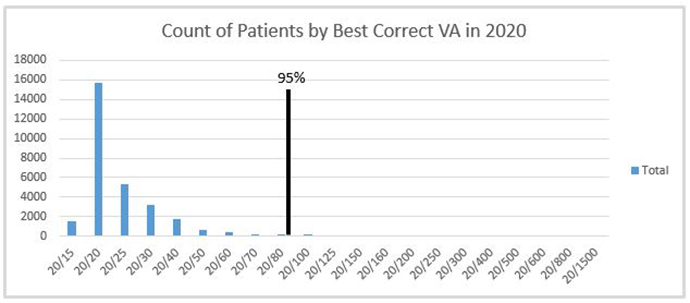The state of the visual health of the population of Oregon
This metric is intended to serve as a quick and concise representation of the state of the visual health of the population of Oregon. To serve this purpose it needs to reflect how well we are doing with identifying and addressing the care of patients with the three leading causes of legal blindness: macular degeneration, glaucoma and diabetic retinopathy.
To attain this goal we analyzed the best corrected visual acuity of all patients seen at the Casey Eye Institute with these three diagnoses. From this analysis we are able to attain the mean visual acuity and the distribution of visual acuity for these patients (see chart below). The minimum visual acuity that encompasses 95% of these patients is given as Oregon’s Visual Acuity. As shown in the chart, for the year 2020 that vision is 20/80. Our goal is for this visual acuity to shift toward 20/20 due to earlier diagnosis, better treatment, and hopefully permanent cures for these conditions.

Current measure is 20/80
The three major causes of legal blindness in Oregon are age-related macular degeneration, glaucoma and diabetes. When we analyze all the patients we have seen in clinic with these three diagnoses, the average visual acuity is 20/25 However, if we look at this population in total, we have to go up to 20/80 to capture 95% of all of the patients being evaluated for these three diseases. This statistical method can be used to assess our progress in addressing Oregon’s overall visual health.